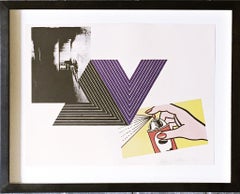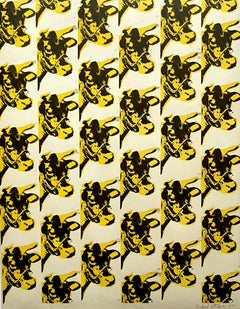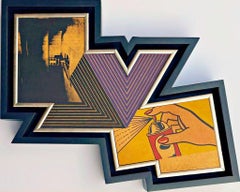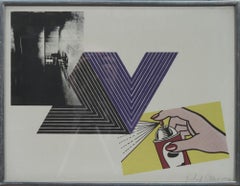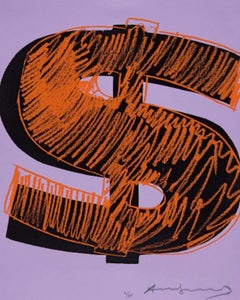Richard Pettibone Art
American, b. 1938
Richard Pettibone (American, b.1938) is one of the pioneering artists to use appropriation techniques. Pettibone was born in Los Angeles, and first worked with shadow boxes and assemblages, illustrating his interest in craft, construction, and working in miniature scales.(Biography provided by ArtWise)
to
3
4
4
4
4
The Pop Art Appropriation Print: Electric Chair, Empress of India, Spray Signed
By Richard Pettibone
Located in New York, NY
Richard Pettibone
The Appropriation Print: Andy Warhol, Frank Stella, Roy Lichtenstein, 1970
(Andy Warhol's Electric Chair, Frank Stella's Empress of India and Roy Lichtenstein's Spray)
Silkscreen in colors on smooth wove paper
Pencil signed and dated 1971 on the front
Frame included:
Elegantly floated and framed in a white wood frame under UV plexiglass in accordance with museum conservation standards
Measurements:
frame: 15 7/8 x 19 3/4 x 1 3/4 inches
sheet: 12 1/4 x 16 inches
This is one of Richard Pettibone's most iconic, popular and desirable prints done in 1970 - during the most influential era of the Pop Art movement. This homage to Andy Warhol, Frank Stella and Roy Lichtenstein exemplifies the type of artistic appropriation he was engaging in early on during the height of the Pop Art movement - long before more contemporary artists like Deborah Kass, Louise Lawler, etc. followed suit. Pencil signed and dated recto. It was created in limited edition - though the exact number is not known.
More about RIchard Pettibone:
As a young painter, Richard Pettibone began replicating on a miniature scale works by newly famous artists, and later also modernist masters, signing the original artist’s name as well as his own. His versions of Andy Warhol’s soup...
Category
1970s Pop Art Richard Pettibone Art
Materials
Pencil, Screen
Andy Warhol Cow Wallpaper
By Richard Pettibone
Located in New York, NY
Richard Pettibone
Andy Warhol Cow Wallpaper
Silkscreen on paper
26 1/2 × 20 3/4 inches
Hand Signed and dated in graphite on the front
Unframed
More about R...
Category
1970s Pop Art Richard Pettibone Art
Materials
Screen
The Appropriation piece: Andy Warhol, Frank Stella, Roy Lichtenstein Unique var.
By Richard Pettibone
Located in New York, NY
Richard Pettibone
The Appropriation Print Andy Warhol, Frank Stella, Roy Lichtenstein, 1970
Silkscreen in colors on masonite board (unique variant on sculpted board)
Hand-signed by artist, Signed and dated on the front (see close up image)
Bespoke frame Included
This is a rare example of Pettibone's iconic Appropriation Print, as it's silkscreened and sculpted on masonite board rather than paper, giving it a different background hue, and enabling it work to be framed so uniquely.
The Appropriation print is one of the most coveted prints Pettibone ever created ; the regular edition is on a full sheet with white background; the present example was silkscreened on board, allowing it to be framed in 3-D. While we do not know how many examples of this graphic work Pettibone created, so far the present work is the only one example we have ever seen on the public market since 1970. (Other editions of The Appropriation Print have been printed on vellum, wove paper and pink and yellow paper.)
This 1970 homage to Andy Warhol, Frank Stella and Roy Lichtenstein exemplifies the type of artistic appropriation he was engaging in early on during the height of the Pop Art movement - long before more contemporary artists like Deborah Kass, Louise Lawler, etc. followed suit.
This silkscreen was in its original 1970 vintage period frame; a bespoke custom hand cut black wood outer frame was subsequently created especially to house the work, giving it a distinctive sculptural aesthetic.
Measurements:
Framed 14.5 inches vertical by 18 inches horizontal by 2 inches
Work
13 inches vertical by 16.5 inches horizontal
Richard Pettibone biography:
Richard Pettibone (American, b.1938) is one of the pioneering artists to use appropriation techniques. Pettibone was born in Los Angeles, and first worked with shadow boxes and assemblages, illustrating his interest in craft, construction, and working in miniature scales. In 1964, he created the first of his appropriated pieces, two tiny painted “replicas” of the iconic Campbell’s soup cans by Andy Warhol (American, 1928–1987). By 1965, he had created several “replicas” of paintings by American artists, such as Warhol, Roy Lichtenstein (1923–1997), Ed Ruscha (b.1937), and others, among them some of the biggest names in Pop Art. Pettibone chose to recreate the work of leading avant-garde artists whose careers were often centered on themes of replication themselves, further lending irony to his work. Pettibone also created both miniature and life-sized sculptural works, including an exact copy of Bicycle Wheel by Marcel Duchamp (French, 1887–1968), and in the 1980s, an entire series of sculptures of varying sizes replicating the most famous works of Constantin Brancusi (Romanian, 1876–1957). In more recent years, Pettibone has created paintings based on the covers of poetry books by Ezra Pound, as well as sculptures drawn from the grid compositions of Piet Mondrian (Dutch, 1872–1944). Pettibone straddles the lines of appropriation, Pop, and Conceptual Art, and has received critical attention for decades for the important questions his work raises about authorship, craftsmanship, and the original in art. His work has been exhibited at the Institute for Contemporary Art in Philadelphia, the Museum of Modern Art in New York, the Museum of Contemporary Art in Miami, and the Laguna Art Museum in Laguna Beach, CA. Pettibone is currently based in New York.
"I wished I had stuck with the idea of just painting the same
painting like the soup can and never painting another painting.
When someone wanted one, you would just do another one.
Does anybody do that now?"
Andy Warhol, 1981
Since the mid-1960s, Richard Pettibone has been making
hand-painted, small-scale copies of works by other artists — a
practice due to which he is best known as a precursor of appropriation art — and for a decade now, he has been revisiting subjects from across his career. In his latest exhibitions at
Castelli Gallery, Pettibone has been showing more of the “same”
paintings that had already been part of his 2005–6 museum retrospective,1
and also including “new” subject matter drawn from
his usual roster of European modernists and American postwar
artists. Art critic Kim Levin laid out some phases of the intricate spectrum from copies to repetitions in her review of the
Warhol-de Chirico showdown, a joint exhibition at the heyday
of appropriation art in the mid-1980s when Warhol’s appropriations of de Chirico’s work effectively revaluated “the grand
old auto-appropriator”.
Upon having counted well over a dozen
Disquieting Muses by de Chirico, Levin speculated: “Maybe he
kept doing them because no one got the point. Maybe he needed the money. Maybe he meant it when he said his technique
had improved, and traditional skills were what mattered.”
On
the other side, Warhol, in her eyes, was the “latter-day exemplar
of museless creativity”.
To Pettibone, traditional skills certainly
still matter, as he practices his contemporary version of museless creativity. He paints the same painting again and again,
no matter whether anybody shows an interest in it or not. His
work, of course, takes place well outside the historical framework of what Levin aptly referred to as the “modern/postmodern wrestling match”,
but neither was this exactly his match
to begin with.
Pettibone is one of appropriation art’s trailblazers, but his diverse
selection of sources removes from his work the critique of the
modernist myth of originality most commonly associated with
appropriation art in a narrow sense, as we see, for example, in
Sherrie Levine’s practice of re-photographing the work of Walker
Evans and Edward Weston. In particular, during his photorealist
phase of the 1970s, Pettibone’s sources ranged widely across
several art-historical periods. His appropriations of the 1980s
and 1990s spanned from Picasso etchings and Brancusi sculptures to Shaker furniture and even included Ezra Pound’s poetry.
Pettibone has professed outright admiration for his source artists, whose work he shrinks and tweaks to comic effect but, nevertheless, always treats with reverence and care. His response
to these artists is primarily on an aesthetic level, owing much
to the fact that his process relies on photographs. By the same
token, the aesthetic that attracts him is a graphic one that lends
itself to reproduction. Painstakingly copying other artists’ work by hand has been a way of making
it his own, yet each source is acknowledged in
his titles and, occasionally, in captions on white
margins that he leaves around the image as an
indication that the actual source is a photographic image. The enjoyment he receives in copying
is part of the motivation behind doing it, as is
the pleasure he receives from actually being with
the finished painting — a considerable private
dimension of his work. His copies are “handmade
readymades” that he meticulously paints in great quantities in his studio upstate in New York; the commitment
to manual labor and the time spent at material production has
become an increasingly important dimension of his recent work.
Pettibone operates at some remove from the contemporary art
scene, not only by staying put geographically, but also by refusing to recoup the simulated lack of originality through the
creation of a public persona.
In so doing, Pettibone takes a real
risk. He places himself in opposition to conceptualism, and he is
apprehensive of an understanding of art as the mere illustration
of an idea. His reading of Marcel Duchamp’s works as beautiful
is revealing about Pettibone’s priorities in this respect.
When
Pettibone, for aesthetic pleasure, paints Duchamp’s Poster...
Category
1970s Pop Art Richard Pettibone Art
Materials
Masonite, Pencil, Screen, Mixed Media
1970 Richard Pettibone 'Appropriation print with Andy Warhol, Frank Stella, and
By Richard Pettibone
Located in Brooklyn, NY
Paper Size: 12.5 x 16.25 inches ( 31.75 x 41.275 cm )
Image Size: 12.5 x 16.25 inches ( 31.75 x 41.275 cm )
Framed: Yes
Condition: A-: Near Mint, very light signs of handling
...
Category
1970s Pop Art Richard Pettibone Art
Materials
Screen
Related Items
Basquiat Enrico Navarra Gallery 2000 (vintage Basquiat announcement)
By after Jean-Michel Basquiat
Located in NEW YORK, NY
Jean-Michel Basquiat Enrico Navarra Gallery Paris 2000:
Rare vintage Basquiat announcement published on the occasion of: Jean-Michel Basquiat, Gallery Enrico Navarra Paris during the...
Category
1980s Pop Art Richard Pettibone Art
Materials
Paper, Lithograph, Offset
Dollar Sign (Unique) Andy Warhol
By Andy Warhol
Located in Palma, ES
EDITION 2/60 with 10 artist’s proofs)
Printed by Rupert Jasen Smith and published by the artist, New York.
See F. & S., II. 274-279 and IIa., 274-279.
Perhaps no other series reflect mass identity, luxury and wealth as prominently as Warhol’s Dollar Sign Series from 1982. The prints from this series are recognizable for repeatedly featuring the American dollar...
Category
1980s Pop Art Richard Pettibone Art
Materials
Screen
Letter to the World, 1986 (#389, Martha Graham)
By Andy Warhol
Located in Greenwich, CT
Letter to the World (FS.II.389) from the Martha Graham portfolio is a unique trial-proof screenprint on paper, 36 x 36 inches, estate-stamped, initialed and numbered with its authent...
Category
20th Century Pop Art Richard Pettibone Art
Materials
Screen, Paper
Keith Haring Club DV8 (announcement)
By (after) Keith Haring
Located in NEW YORK, NY
Keith Haring Club DV8 San Francisco 1992:
A rare, historic Keith Haring announcement card for Club DV8's pre-opening construction party, Friday December 4th, 1992; CLVB DV8, San Francisco. This party was dedicated to Keith Haring and even included a Keith Haring room.
Offset printed announcement card.
Dimensions 6 x 4 inches.
Very good vintage condition.
Unsigned from an edition of unknown; rare.
Further Background:
"Haring’s work has long been a part of San Francisco’s ocular culture. He created works for diverse venues in San Francisco during his lifetime, including murals for DV8, a club once located in the South of Market neighborhood, and a huge, multi-panel painting for the South of Market Child-care Center (also known as the Saint Patrick’s Daycare Center). Haring’s outdoor sculpture Untitled (Three Dancing Figures 1989), located at Third and Howard Streets, is a prominent feature of Moscone Convention Center, and his triptych altarpiece The Life of Christ (1990) is installed in the AIDS Chapel at Grace...
Category
1980s Pop Art Richard Pettibone Art
Materials
Lithograph, Offset
Basquiat Enrico Navarra Gallery 2000 (vintage Basquiat announcement)
By after Jean-Michel Basquiat
Located in NEW YORK, NY
Jean-Michel Basquiat Enrico Navarra Gallery Paris 1999-2000:
A set of 2 rare vintage Basquiat announcement cards published on the occasion(s) of:
Jean-Michel Basquiat, Gallery Enri...
Category
1980s Pop Art Richard Pettibone Art
Materials
Paper, Lithograph, Offset
Lenin, 1987 (#402/403)
By Andy Warhol
Located in Greenwich, CT
Lenin (FS.IIB.402-403) is a unique trial-proof screenprint on paper, 42.62 x 30.25 inches, signed 'Andy Warhol' and numbered TP 2/46 lower left. Framed in a contemporary gold leaf, closed-corner frame.
LITERATURE
F. Feldman, J. Schellmann, and C. Defendi, Andy Warhol Prints: A Catalogue Raisonné: 1962-1987, 4th ed. New York: D.A.P. Inc, 2003, pp.210 and 221, IIB.402 IIB.403
Though Warhol began his career as a fashion and children’s book illustrator, much of his later work focused on fame, consumer culture and the cult of celebrities as signifiers. In his exploration of fame, he would occasionally dip into the pool of politics and politicians. In the last year before his death in 1987, using a photograph by Philipp Schönborn, Warhol centered his attention on one of his final subjects - Vladimir Lenin. Known as one of the most influential political figures of the 20th century, Lenin was the undisputed political engineer and founder of the one-party socialist state. Lenin played a pivotal role in changing the course of Russian history...
Category
20th Century Pop Art Richard Pettibone Art
Materials
Screen, Paper
Jasper Johns Untitled
By Jasper Johns
Located in Washington, DC
Artist: Jasper Johns
Title: Untitled
Medium: Screenprint in colors on Patapar printing parchment
Year: 1977
Edition: 3000
Frame Size: 17" x 17"
Sheet Size: 10 5/8" x 10 1/4"
Image Si...
Category
1970s Pop Art Richard Pettibone Art
Materials
Screen
Goethe, FS II.270
By Andy Warhol
Located in Palm Desert, CA
"Goethe" is a silkscreen in colors made by Andy Warhol in 1982. The work is signed and editioned in graphite, lower left, "70/100 Andy Warhol". The artwork size is 38 x 38 inches. Th...
Category
Late 20th Century Pop Art Richard Pettibone Art
Materials
Screen
Andy Warhol Shoes poster 1979 (1970s Andy Warhol)
By Andy Warhol
Located in NEW YORK, NY
Andy Warhol illustrated advertising poster New York, 1979:
1970s Andy Warhol illustrated "Lighthouse Footwear Reptile Shoes," poster (New York, 1979). An elegant & well-sized vintage Andy Warhol poster executed during the artist’s lifetime. Warhol printed signature appears lower right. Catalog Raisonne: Andy Warhol: The Complete Commissioned Posters, 1964-1987 (entry 12; Marechal). Looks fantastic framed.
Offset lithograph in colors on wove paper. Linen backed.
30 x 45 inches (76.1 x 114.3 cm).
Well-preserved and in very good overall vintage condition with the exception of perhaps some minor signs of handling. Poster is linen backed and ready for framing.
Printed Warhol signature...
Category
1960s Pop Art Richard Pettibone Art
Materials
Lithograph, Offset
Original 1980s Keith Haring Pop Shop Tokyo bag (Keith Haring pop shop New York)
By Keith Haring
Located in NEW YORK, NY
Keith Haring Pop Shop Tokyo 1988:
Rare vintage original 1980s Keith Haring Pop Shop Tokyo bag designed & illustrated by the artist. Features a bold Keith Haring printed signature and...
Category
1980s Pop Art Richard Pettibone Art
Materials
Plastic, Screen
Cow
By Andy Warhol
Located in New York, NY
A very good impression of this color screenprint on wallpaper. Printed by Bill Miller's Wallpaper Studio, Inc., New York. Published by Factory Additions, New York, with the copyright...
Category
1970s Pop Art Richard Pettibone Art
Materials
Screen, Color
Keith Haring Club DV8 poster 1991 (Keith Haring balloon dog)
By (after) Keith Haring
Located in NEW YORK, NY
Keith Haring Club DV8 San Francisco 1991:
A rare 1991 Club DV8's poster featuring Keith Haring balloon dog artwork originally created by the artist for DV...
Category
1990s Pop Art Richard Pettibone Art
Materials
Lithograph, Offset
Richard Pettibone art for sale on 1stDibs.
Find a wide variety of authentic Richard Pettibone art available for sale on 1stDibs. You can also browse by medium to find art by Richard Pettibone in screen print, masonite, mixed media and more. Much of the original work by this artist or collective was created during the 1970s and is mostly associated with the Pop Art style. Not every interior allows for large Richard Pettibone art, so small editions measuring 17 inches across are available. Customers who are interested in this artist might also find the work of Corita Kent, Oyvind Fahlstrom, and Peter Phillips. Richard Pettibone art prices can differ depending upon medium, time period and other attributes. On 1stDibs, the price for these items starts at $5,000 and tops out at $15,000, while the average work can sell for $7,250.
